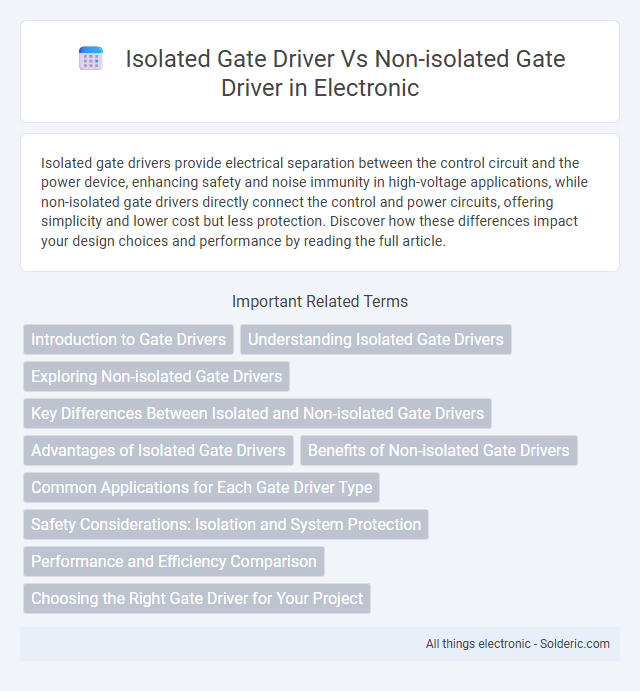Isolated gate drivers provide electrical separation between the control circuit and the power device, enhancing safety and noise immunity in high-voltage applications, while non-isolated gate drivers directly connect the control and power circuits, offering simplicity and lower cost but less protection. Discover how these differences impact your design choices and performance by reading the full article.
Comparison Table
| Feature | Isolated Gate Driver | Non-isolated Gate Driver |
|---|---|---|
| Electrical Isolation | Provides galvanic isolation between control and power circuits | No electrical isolation; direct electrical connection |
| Safety | Enhances user and system safety by preventing high-voltage exposure | Lower safety in high-voltage applications due to lack of isolation |
| Noise Immunity | High immunity against noise and voltage spikes | Lower immunity; susceptible to noise disturbances |
| Application | Suitable for high-voltage, industrial, and medical applications | Used in low-voltage, cost-sensitive, and compact applications |
| Cost | Higher due to isolation components (transformers, optocouplers) | Lower cost; simpler design and components |
| Complexity | More complex design with isolation barriers | Simpler design without isolation requirements |
| Signal Integrity | Maintains signal integrity across isolation barrier | Signal integrity can degrade in noisy environments |
| Size | Larger due to isolation hardware | Smaller and compact design |
Introduction to Gate Drivers
Gate drivers are crucial components in power electronics, responsible for controlling the switching of power transistors such as MOSFETs and IGBTs. Isolated gate drivers provide electrical isolation between the control and power circuits, enhancing safety and noise immunity, which is essential in high-voltage applications. Non-isolated gate drivers lack this isolation, resulting in simpler designs suitable for low-voltage or cost-sensitive environments where isolation is not critical.
Understanding Isolated Gate Drivers
Isolated gate drivers provide galvanic isolation between the control signal and power stages, ensuring enhanced safety and noise immunity in power electronics applications. They are essential for high-voltage systems, preventing ground loops and protecting low-voltage control circuits from high-voltage spikes and transient voltages. In contrast, non-isolated gate drivers share a common ground and are suitable for low-voltage, less complex circuits where isolation is not critical.
Exploring Non-isolated Gate Drivers
Non-isolated gate drivers directly connect the control and power grounds, enabling simplified circuit design and cost reduction compared to isolated gate drivers. These drivers offer efficient switching performance for applications where the voltage levels between control and power circuits are compatible. Commonly used in low-voltage DC-DC converters and motor control systems, non-isolated gate drivers provide compactness and ease of integration but require careful layout to avoid ground loop interference.
Key Differences Between Isolated and Non-isolated Gate Drivers
Isolated gate drivers provide electrical isolation between the control and power circuits, enhancing safety and noise immunity in high-voltage applications, whereas non-isolated gate drivers directly connect the control and power stages, offering simpler design and lower cost but less protection. Key differences include isolation voltage rating, signal integrity, and application suitability, with isolated drivers favored for industrial and automotive environments requiring high safety standards. Your choice depends on system requirements for isolation, voltage levels, and complexity in switching power devices.
Advantages of Isolated Gate Drivers
Isolated gate drivers offer superior electrical isolation, enhancing safety and protecting sensitive control circuits from high-voltage transients and noise. They enable reliable operation in high-voltage applications such as motor drives and power inverters by preventing ground loop issues and improving system robustness. Compared to non-isolated drivers, isolated gate drivers significantly reduce electromagnetic interference (EMI) and enhance overall system reliability and efficiency.
Benefits of Non-isolated Gate Drivers
Non-isolated gate drivers offer benefits such as lower cost, simpler design, and higher efficiency by directly interfacing with the power stage without requiring additional isolation components. These drivers often provide faster switching speeds and reduced propagation delay, improving overall system performance. Your application benefits from compact size and reduced electromagnetic interference due to the absence of isolation barriers.
Common Applications for Each Gate Driver Type
Isolated gate drivers find common applications in high-voltage systems such as solar inverters, motor drives, and industrial power supplies where electrical isolation is critical for safety and noise reduction. Non-isolated gate drivers are typically used in lower voltage applications like DC-DC converters, point-of-load regulators, and battery management systems, where electrical isolation is not a primary concern. The choice between isolated and non-isolated gate drivers is often determined by the system's voltage level, safety requirements, and noise immunity.
Safety Considerations: Isolation and System Protection
Isolated gate drivers provide galvanic isolation between control and power circuits, enhancing safety by preventing high-voltage faults from damaging control electronics and reducing the risk of electric shock. Non-isolated gate drivers lack this isolation, making them more susceptible to ground loops and voltage spikes that can compromise system integrity and operator safety. Isolation in gate drivers is critical for applications involving high voltages or noisy environments, as it ensures reliable system protection and long-term operational stability.
Performance and Efficiency Comparison
Isolated gate drivers provide enhanced safety and noise immunity by electrically separating the control and power circuits, resulting in improved performance in high-voltage and high-frequency applications. Non-isolated gate drivers offer lower cost and smaller footprint but may suffer from increased electromagnetic interference and reduced signal integrity, impacting efficiency in demanding environments. The choice between isolated and non-isolated gate drivers hinges on balancing system complexity, efficiency requirements, and operational voltage levels for optimal performance.
Choosing the Right Gate Driver for Your Project
Selecting the right gate driver for your project depends on voltage levels, isolation requirements, and application safety. Isolated gate drivers provide galvanic isolation, protecting low-voltage control circuits from high-voltage loads, ideal for applications like motor drives or power inverters. Non-isolated gate drivers suit simpler designs with common grounds, offering cost-efficient switching control without isolation overhead.
Isolated Gate Driver vs Non-isolated Gate Driver Infographic

 solderic.com
solderic.com